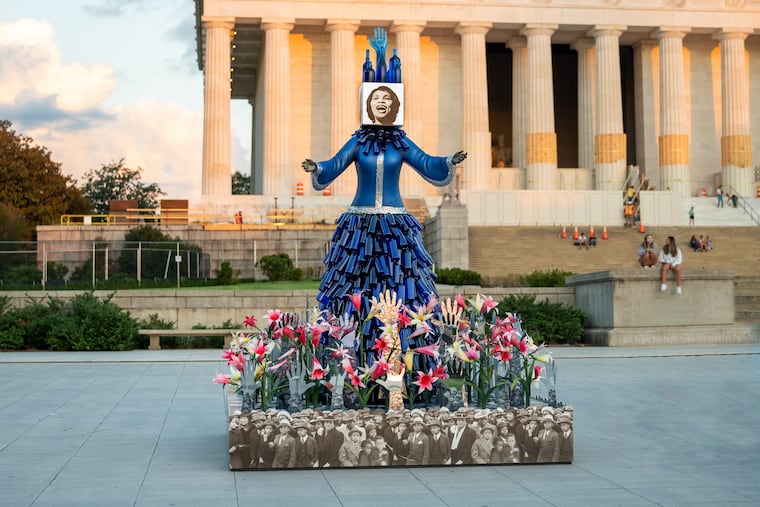Marian Anderson and the Liberty Bell inspire new artworks on the National Mall
Eighty years after she sang for 75,000 people in a concert at the Lincoln Memorial, Anderson's legacy is being honored by a Monument Lab exhibit.

In 1939, Philadelphia-raised opera legend Marian Anderson was supposed to play D.C.’s Constitution Hall, but the venue’s owners, the Daughters of the American Revolution, refused to let a Black woman perform. Instead, she sang for 75,000 people in a concert at the Lincoln Memorial, opening with the patriotic song “My Country, ‘Tis of Thee.”
Now, more than 80 years later, Anderson has returned to the National Mall as a sculpture, in a new exhibit curated by Philly’s Monument Lab, the nonprofit studio for public art and history based in Center City.
The larger-than-life Of Thee We Sing is one of six works in “Beyond Granite: Pulling Together,” the first multi-artist exhibit held on the National Mall, running through Sept. 18. The work is by vanessa german, a North Carolina-based artist who spent her formative years in Pittsburgh, where she taught art and was an artist-in-residence at the Frick Pittsburgh.
The title references a tweak Anderson made to the lyrics of her opening song, to sing “of thee we sing” instead of “of thee I sing.”
The artist used a collage of materials to depict a towering Anderson standing atop a platform of black-and-white photographs of the multigenerational crowd that gathered at the Mall in 1939. Blue bottles — representing those used by enslaved Africans in the Gullah region to capture evil spirits — comprise the sculpture’s skirt and headpiece. Lilies and cutouts of outstretched hands rise from beneath her.
Paul Farber, cofounder of the Monument Lab, worked with Salamishah Tillet, a professor of African American studies and creative writing at Rutgers University, to curate the exhibit in partnership with the Trust for the National Mall, the National Park Service, and the National Capital Planning Commission. The guiding question for the exhibit was “What stories remain untold on the National Mall?”
“There is no granite or bronze monument to her on the Mall, but her name is spoken here every day, by scores of visitors, tour guides, and we wanted to bring her to the foreground,” said Farber, who once lived blocks from Philly’s Union Baptist Church (formerly at 12th and Bainbridge Streets) where Anderson sang as a child.
The exhibition is funded by the Mellon Foundation, which also gave a $4 million grant to Monument Lab in 2021 to diversify and reimagine public monuments in Philly and beyond.
“Beyond Granite” also features Paul Ramírez Jonas’ bell sculpture, Let Freedom Ring. The work, Farber says, was partially inspired by the Liberty Bell. “We heard a comment from one of our advisers that one of the most challenging aspects of the Liberty Bell, despite its aspiration of freedom through time, is that you can’t ring it,” he said. In Ramírez Jonas’s sculpture, visitors can play the final note in “My Country ‘Tis of Thee” — referencing the same song Anderson performed in 1939 — on a 600-pound bell.
Other installations in the exhibit are work from Derrick Adams, who created a playground reflecting desegregation; Tiffany Chung, who uses colorful rope to trace the routes of Southeast Asian immigrants and refugees following the Vietnam War; Ashon Crawley, whose audiovisual work about the impact of HIV honors Black queer church musicians; and Wendy Red Star, who used her own fingerprint to create a large red thumb print containing the names of the Apsáalooke (Crow) Nation chiefs who signed treaties with the U.S. government.
“Beyond Granite: Pulling Together” runs through Sept. 18 on the National Mall in Washington.